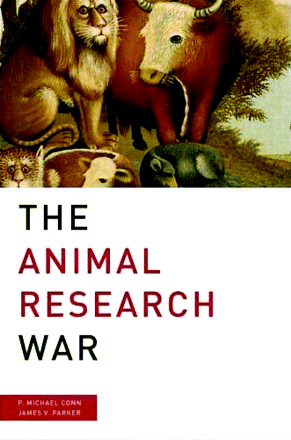If We Could Talk About Animals
The Animal Research War.

P. Michael Conn and James V. Parker., New York: Palgrave Macmillan; 2008., 224 pages. $34.95., ISBN: 978-0230600140
“Given the same amount of intelligence, timidity will do a thousand times more damage than audacity.”
— Karl von Clausewitz
Alexander Hamilton, the great patriot of the American Revolutionary War, once opined, “Those who stand for nothing fall for anything.” Now, P. Michael Conn and James V. Parker raise their own battle cry to alert biomedical researchers as well as an uninformed public about the rise of animal rights terrorism. Many of the “War Stories” (as one chapter is aptly named) in this information-packed book will be familiar to researchers across the country, and quite frankly, Conn and Parker’s fine and compelling message is more sorely in need of hearing among the non-scientific public. But the authors offer more than a rehash of past animal terrorism episodes, and their publication is worthy of the attention of the scientific community.
Conn’s introduction to animal rights extremism is offered as a wake-up call, which he himself appears to have received none too early. The animal rights movement had remained “distant and irrelevant” in his own consciousness until he arrived at the Oregon Health and Science University. There, he and other investigators became targeted by animal rights terrorists who had rigged envelopes, addressed to Conn and others, with razor blades. Now battle-scarred, the authors attempt to dispel ivory tower complacency about animal rights terrorists.
The book is highly readable and includes a substantial appendix of additional resources, notes, and a question-and-answer section for those not familiar with the conduct of responsible animal use in biomedical research. The brevity of the book belies the great deal of useful information it contains, and if there is a quibble, it is only that some sections will leave the reader longing for more than brevity allows. Two particularly interesting segments deal with subjects that have not been well reported in the general or scientific press. In the first of these, Conn and Parker expose how the animal rights movement has begun to co-opt certain mainstream environmental movements, often to the chagrin of many mainstream environmentalists. In a second instance, covering the animal personhood agenda, the authors detail the fallacies and rhetorical shortcomings of speciesism, and they do a remarkable job of explaining, both to the scientifically illiterate and less extensively informed, the similarities and differences between human and non-human DNA; the implications for biomedical research, should animals ever be granted “rights,” are intriguingly outlined.
Conn and Parker’s vivid narratives provide interesting insights into the animal rights movement and the making of an animal rights terrorist. The success of the movement, its tactics and strategies, and the public support it has garnered form the basis for a compelling psychological analysis and may recall an American war protagonist1 more recent to us than Hamilton (if not quite as distinguished), who said, “There are a lot of people who lie and get away with it.” The authors poignantly describe what a world devoid of animal experimentation would look like, in the event that animal rights extremism should succeed entirely. The impact of such a scenario upon graduate, veterinary, and medical school education and concomitantly upon human health is horrific.
The authors also recap some well-publicized institutional failures, notably the case at Ohio State University, where investigator Michael Podell’s laboratory was closed in response to animal extremists. In this and other instances, academic institutions appear to have capitulated to assaults from animal terrorists, but even more apparent is the degree to which the authors bring the corporate world to task for having failed to rise to the challenge to animal research.
Conn and Parker also point to some encouraging pro-research activities that the United Kingdom is developing to respond to animal terrorists. Conn and Parker’s book should interest many different audiences: high school biology teachers and their students; patients who care enough to learn about medical research and the genesis of the therapies they rely on; and those well-meaning individuals who naively conflate animal welfare with animal rights. Researchers at the bench, university administrators, and everyone who works to advance the research enterprise will benefit from the lessons so well articulated in Conn and Parker’s book. After all, Hamilton’s admonition rings true today. (Sadly, so does Rumsfeld’s1.)
Footnotes
-
↵1 Donald Rumsfeld, as quoted in the New York Times, April18, 2003. [See <http://query.nytimes.com/gst/fullpage.html?res=940CE1D7173AF93BA25757C0A9659C8B63>; accessed, 25 May 2008.]
- © American Society for Pharmacology and Experimental Theraputics 2008



